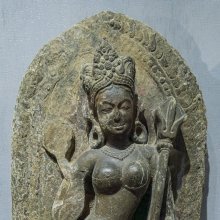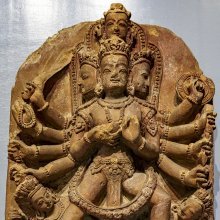Mahagauri, Mahāgauri, Mahāgaurī, Mahā-gauri, Mahā-gauri, Maha-gauri: 9 definitions
Introduction:
Mahagauri means something in Hinduism, Sanskrit. If you want to know the exact meaning, history, etymology or English translation of this term then check out the descriptions on this page. Add your comment or reference to a book if you want to contribute to this summary article.
Images (photo gallery)
In Hinduism
Purana and Itihasa (epic history)
Source: archive.org: Puranic EncyclopediaMahāgauri (महागौरि).—A prominent river in India. (Mahābhārata, Bhīṣma Parva, Chapter 9, Verse 33).
Source: Cologne Digital Sanskrit Dictionaries: The Purana IndexMahāgaurī (महागौरी).—A river from the Vindhyas.*
- * Brahmāṇḍa-purāṇa II. 16. 33; Matsya-purāṇa 114. 28; Vāyu-purāṇa 45. 103.
Mahāgaurī (महागौरी) refers to the name of a River mentioned in the Mahābhārata (cf. VI.10.32). Note: The Mahābhārata (mentioning Mahāgaurī) is a Sanskrit epic poem consisting of 100,000 ślokas (metrical verses) and is over 2000 years old.

The Purana (पुराण, purāṇas) refers to Sanskrit literature preserving ancient India’s vast cultural history, including historical legends, religious ceremonies, various arts and sciences. The eighteen mahapuranas total over 400,000 shlokas (metrical couplets) and date to at least several centuries BCE.
Shaktism (Shakta philosophy)
Source: Google Books: ManthanabhairavatantramMahāgaurī (महागौरी) is an epithet for the Goddess according to the Bhairavīstotra in the Śrīmatottara-tantra, an expansion of the Kubjikāmatatantra: the earliest popular and most authoritative Tantra of the Kubjikā cult.—Accordingly, “Victory! Victory (to you) O goddess (bhagavatī)! (You) who are like the solar orb of the emergence of Supreme Reality! (You who are) the star that is the circle of all the directions illumined by the halo of the light of your own body! O plane of stability! (You whose) body of enjoyment (saṃbhogadeha) is radiant white (svacchā) and unlimited in all (its) limbs! O Mahāgaurī (Great White One)! [...]”
Source: Hare-Krsna: Nava-DurgāMahāgaurī (महागौरी) refers to one of the nine Navadurgā which literally means the “nine forms of Goddess Durgā”, and constitute, according to Vedic scriptures, the manifestation of Durgā in Her nine different aspects. [...] Each goddess [viz., Mahāgaurī] has a different form and a special significance.

Shakta (शाक्त, śākta) or Shaktism (śāktism) represents a tradition of Hinduism where the Goddess (Devi) is revered and worshipped. Shakta literature includes a range of scriptures, including various Agamas and Tantras, although its roots may be traced back to the Vedas.
Languages of India and abroad
Sanskrit dictionary
Source: Cologne Digital Sanskrit Dictionaries: Monier-Williams Sanskrit-English Dictionary1) Mahāgaurī (महागौरी):—[=mahā-gaurī] [from mahā > mah] f. one of the 9 forms of Durgā, [Catalogue(s)]
2) [v.s. ...] Name of a river, [Mahābhārata; Mārkaṇḍeya-purāṇa]
[Sanskrit to German]
Sanskrit, also spelled संस्कृतम् (saṃskṛtam), is an ancient language of India commonly seen as the grandmother of the Indo-European language family (even English!). Closely allied with Prakrit and Pali, Sanskrit is more exhaustive in both grammar and terms and has the most extensive collection of literature in the world, greatly surpassing its sister-languages Greek and Latin.
Nepali dictionary
Source: unoes: Nepali-English DictionaryMahāgaurī (महागौरी):—n. 1. the eighth of nine Gauris worshipped in Dashain; 2. a red cane;
Nepali is the primary language of the Nepalese people counting almost 20 million native speakers. The country of Nepal is situated in the Himalaya mountain range to the north of India.
See also (Relevant definitions)
Starts with: Mahagauripujapaddhati, Mahagaurivita.
Full-text: Navagraha, Navadurga, Sambhogadeha, Gaura, Svaccha, Durga.
Relevant text
Search found 13 books and stories containing Mahagauri, Mahā-gauri, Mahā-gauri, Maha-gauri, Mahā-gaurī, Mahāgauri, Mahāgaurī; (plurals include: Mahagauris, gauris, gaurīs, Mahāgauris, Mahāgaurīs). You can also click to the full overview containing English textual excerpts. Below are direct links for the most relevant articles:
List of Mahabharata people and places (by Laxman Burdak)
The Agni Purana (by N. Gangadharan)
Chapter 98 - Mode of installation of the image of goddess Gaurī (gaurīpratiṣṭhā)
Chapter 96 - Mode of initial consecration of an image (adhivāsana)
Puranic encyclopaedia (by Vettam Mani)
Lalitopakhyana (Lalita Mahatmya) (by G.V. Tagare)
The Brahmanda Purana (by G.V. Tagare)
Chapter 16 - The Description of Bharata < [Section 2 - Anuṣaṅga-pāda]


